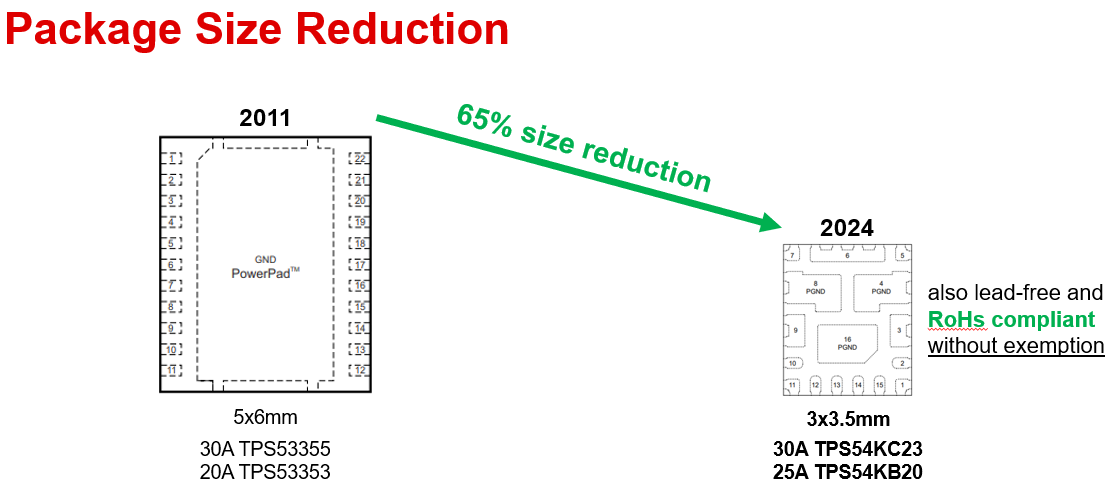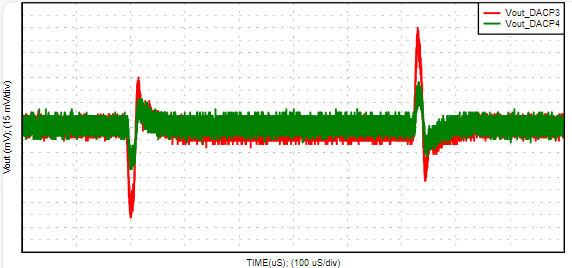SLVAFX5 October 2024 TPS53353 , TPS53355 , TPS54KB20 , TPS54KC23
Abstract
The TPS54Kx family (TPS54KB20, TPS54KC23) is the next generation to the TPS5335x (TPS53353, TPS53355) family. This application brief explains the improvements made from the previous version to the new version and how those changes benefit the designer. Key concepts discussed further include:
- Feature sets contribute to a smaller design size and higher-power density
- Increased flexibility enables applicability to a wide range of applications
- Advantages of D-CAP4™ technology
Introduction
The TPS54Kx family (TPS54KB20, TPS54KC23) is the next generation of 16V, high-efficiency, remote sensing, and D-CAP4™ synchronous step-down DC-DC converters that improves upon the previous family TPS5335x (TPS53353, TPS53355). Table 1 shows the key features of each products and the improvements on the latest generation family. This application brief provides a comparison between these two device families and an explanation of how the changes benefit the user more than the previous version.
| GPN | TPS54KB20 | TPS54KC23 | TPS53353 | TPS53355 |
| Iout | 25A | 30A | 20A | 30A |
| Vin | 4V to 16V | 4V to 16V | 1.5V to 15V | 30A |
| Vout | 0.6V to 5.5V | 0.6V to 5.5V | 0.6V to 5.5V | 0.6V to 5.5V |
| Control | D-CAP4 | D-CAP4 | D-CAP | D-CAP |
| Rds(on) | 5.8/2.3mΩ | 5.8/2.3mΩ | 5/2mΩ | 5/2mΩ |
| Fsw | 0.8/1.1/1.4MHz | 0.8/1.1/1.4MHz | 250kHz to 1MHz | 250kHz to 1MHz |
| Light Load | Yes | Yes | Yes | Yes |
| Vref (-40C Tj +125C) | 0.50% | 0.50% | 1% | 1% |
| Remote Sense | Yes | Yes | No | No |
| EN/PG/adj. SS | Yes | Yes | Yes | Yes |
| Package | 3x3.5mm | 3x3.5mm | 5x6mm | 5x6mm |
| Tja | 13.2C/W | 13.2C/W | 27.2C/W | 27.2C/W |
| RoHS Compliant | Yes | Yes | Yes | Yes |
Performance
Efficiency
When comparing the TPS54Kx family (TPS54KB20, TPS54KC23) and the TPS5335x (TPS53353, TPS53355) family one of the most important factors to consider is the efficiency of both devices. TPS54KB20 offers great performance across a wide range of applications under 25A and goes up to 30A when using TPS54KC23. While the TPS53355 has a lower RDSon, the TPS54KC23 is much more efficient. This is because RDSon only contributes to conduction loss, whereas other major losses are significantly reduced due to our improvements in process technology, packaging technology, and control techniques. Figure 1 notes that TPS54KC23 provides 5% higher efficiency at half-load than 30A TPS53355.
| Device | Package | Rds(on) |
| TPS54KC23 | 3x3.5mm | 5.8/2.3mΩ |
| TPS53355 | 5x6mm | 5/2mΩ |
 Figure 1 TPS54KC23 versus TPS53355
Efficiency comparison.
Figure 1 TPS54KC23 versus TPS53355
Efficiency comparison. Thermal Performance
In terms of thermal performance, there is a significant improvement when comparing both device families thanks to technology improvements and the butterfly layout the new generation offers. Figure 2 shows the temperature of a TPS54KB20 board.
 Figure 2 Thermal Image – 3.3V
Output, TPS54KB20EVM, 6 Layers
Figure 2 Thermal Image – 3.3V
Output, TPS54KB20EVM, 6 LayersSolution Size
The TPS54Kx family (TPS54KB20, TPS54KC23) comes in TI’s new butterfly-style footprint which is unique to this family of devices. This layout features two VIN ports in parallel and two PGND planes in parallel. This layout method minimizes parasitics and noise while further enhancing performance by increasing efficiency and reducing ringing. Furthermore, the butterfly footprint arranges the input capacitors in such a way that magnetic field cancellation occurs, leading to loop inductance being decreased. When it comes to size comparison the TPS54Kx family offers reduction in design size compared to the TPS5335x (TPS53353, TPS53355) family due to the butterfly footprint's ability to compress component placement on the layout. TPS54KB2x family comes in a 3x3.5mm 16 Pin QFN package and the TPS5335x family comes in a 6x5mm 22 Pin LSON package. This 65% size reduction is a major factor when working with a space constricted design. Below Figure 3 shows the size reduction of both families and Figure 4 shows the difference efficiency between the symmetrical butterfly layout and the standard asymmetrical layout.
 Figure 3 Layout and Size
Comparison
Figure 3 Layout and Size
Comparison Figure 4 Symmetrical and
Asymmetrical Efficiency.
Figure 4 Symmetrical and
Asymmetrical Efficiency. D-CAP4™ Technology
The TPS54Kx family (TPS54KB20, TPS54KC23) offers the latest D-CAP4™ technology which offers the advantages of D-CAP3™ while having fixed ramp amplitude over the entire output voltage range to improve transient response, especially at a higher Vout. The TPS54Kx family also offers less overshoot and undershoot due to requiring less output capacitance while still having the same transients. D-CAP4™ technology allows the TPS54Kx family to have better performance when compared to the previous family TPS5335x (TPS53353, TPS53355). Figure 5 shows the difference in transient performance between D-CAP3™ and the latest D-CAP4™.
 Figure 5 D-CAP4™ versus D-CAP3™
Transient Performance
Figure 5 D-CAP4™ versus D-CAP3™
Transient PerformanceConclusion
The comparison between the TPS54KB20 Family and TPS53353 Family exemplifies the improvements in the new generation and how those improvements benefit the design the devices are in. Decreased solution size, increased efficiency, implementation of D-CAP4™ and the butterfly layout, and more all combine together to make significant advancements in the buck converter design for mid voltage applications.
Additional Resources
- Texas Instruments, Analyzing Butterfly-Style Footprint and Input Capacitor Removal Effects, application note
- Texas Instruments, TPS54KB2x 4V to 16V Input, 25A, Remote Sense, D-CAP4 Synchronous Buck Converter, data sheet
- Texas Instruments, Control-mode quick reference guide, analog design journal